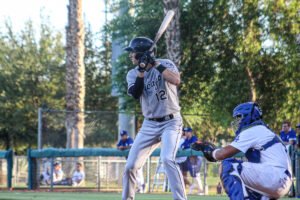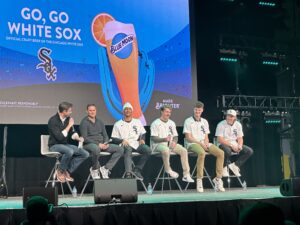Emptying the Notebook: A-ball pitchers
I already wrote up focus pieces on two key starting pitching prospects based on my trip through the A-ball affiliates – you can read all about Dylan Cease and Kade McClure.
But I saw two other starters and a bunch of relievers in four games at Winston-Salem and Kannapolis, and they deserve some attention as well. Some could break into the Top 30 in the near future. So below I’m emptying the notebook on those two starters and seven relievers from the Class A ballclubs, including videos for each. Now you too can you impress your friends with knowledge of lesser-known prospects that are also part of the rebuild.
Bernardo Flores, LHSP, Winston-Salem

I took in Flores’ start on April 12th. Ranked 30th in our latest Top 30 prospects, Bernardo has been a bit of an enigma since the Sox drafted him in the 7th round in 2016. We got a look at him last year in Kannapolis too, and you can read that write-up here. In this game he managed to throw 5.1 innings of shutout baseball on a bit of a tightrope before things started to deteriorate.
Having seen him pitch before, what I was looking for were changes. So let’s break him down in a before and after comparison, May 2017 versus April 2018.
DELIVERY: A few small changes. Hands aren’t as exaggeratedly high, slot is maybe a higher 3/4. But still lots of body rotation, quick and high leg kick, and average apparent effort level. Here’s an open side video:
STUFF: Fastball velocity increased a bit – was 83 to 90 (2S, 4S) last year, 86-92 this year for the pairing. He did hold that velocity throughout too, which was an issue last year, so he’s clearly gotten stronger. Curveball was identical – across most of 70s with good bend but some loopiness in the lower bands, a little more bite in the upper. His change-up is in a much tighter band now around 79-82 and he can locate it a little better but the arm still slows. Entirely new in our viewings was a slider in the low 80’s that didn’t show much on this day. As with previous viewings, his stuff is all pretty heavy.
Here’s a 3-pitch at-bat, all fastballs:
And this one shows a 2-seamer, change and curve:
Location command seemed tight at times and loose at others. The telegraphing of pitches is something Flores will need to focus on mitigating as well. There is clearly improvement here, his give and take of FB velocity could work well, and the change-up is a nice looking pitch.
Lincoln Henzman, RHSP, Kannapolis

This was the first look at Henzman for FutureSox, after he was selected in the 4th round of last year’s draft. I took in his April 11th outing in Kannapolis, his second start of the year. Henzman is an athletically-built at 6’2”, but he looks longer with exaggerated hand pumps and an extended leg kick. His delivery is relatively low effort, and he gets some deception from a delivery that seems to pop quick from his shoulder. Lincoln works quickly on the mound.
Here’s a rundown of his repertoire:
- Everything is heavy – this is a true sinker-baller
- Fastball was mostly 90-91, with a few 92’s and a few 89’s, with sink
- Slider around 83-85 wasn’t biting much in this viewing, mostly drop
- Change-up in the low 80’s was lesser-used but shows both drop and fade-back
- Curve in the low to mid-70’s showed a nice 12/5 character and was his best-looking offspeed pitch
The fact that everything was so heavy was apparent in that most of the hits against him were grounders that found holes. There was very little hard contact off Henzman. Here’s a sample of the type of hits he was mostly giving up:
But the most impressive thing was his command, especially for someone this early in their pro career. He seemed to be locating very well, and the character of his pitches was pretty consistent. He worked in on hitters’ hands plenty too. Here’s another video, this one featuring the curve, slider and fastball, working the edges of the plate nicely (ends with Casey Golden reaching out to punch an outside pitch for a soft liner that turned into a double play):
On the flipside, no one of Lincoln’s pitches stands out or showed plus characteristics. His success is in the command of all four offerings and that he delivers with minimal detectability of what pitch is coming out of his hand. His velocity held steady until the 7th inning, when he started showing a little more effort and the speed came down just a bit. Not unusual for pitchers at this level, he’s still building up stamina.
Henzman spent the balance of his college career as a reliever, but the Sox have stated they want him to start. From what I saw, I’d agree that he should keep at this role. His four-pitch arsenal is a good framework to hang development time on.
Tyler Johnson, RHRP, Kannapolis

Going from the 4th rounder to the 5th rounder of 2017, we have a pitcher who is quite the opposite of Henzman. Tyler Johnson is a flame-throwing right-handed reliever with loud stuff but not much command yet.
Let’s start with the bad news. Johnson’s delivery has a number of potential hazards. He’s arm-heavy with something of a slide-step, there’s lots of rotation, balance is iffy, arm bounce, and he’s a slinger with a fair amount of effort. Most definitely related, his command is quite loose. Take a look at this at-bat early in his appearance, where by my count the catcher had to reach substantially away from his target on four of five pitches for a walk:
But here’s the good news. Johnson’s fastball is a serious burner, running 94 to 98 with lots of life. Probably 90% of his pitches in this look were heaters. The other 10% were sliders in the low 90’s that bit hard. Both pitches show plus potential, even if he’s got some distance to go before he commands them. Here’s a 3-pitch strikeout showing the better side:
Going into 2018 the thought process heard around Johnson was that as a reliever he could move up quickly. But from what I saw, and what others have seen so far this year, I wouldn’t rely on that. There are just too many things that need work. But I also am a firm believer in the talent here, with a ceiling as a high leverage reliever the major league level.
Danny Dopico, RHRP, Winston-Salem

What if I told you there was a reliever in the White Sox system you’d probably never heard of, who has: one pitch that shows present plus action, another that shows present above average overall, and a third that shows close to major league average?
This was my third in-person viewing of Danny Dopico and his low-3/4 slinging action in the past couple seasons. The term I’d use to describe him – one which a scout I was sitting near agreed with – is “tease”. His bread and butter is a fastball around 94-96 with some run to it. His out pitch is a splitter around 83-85 that moves like a corkscrew and has one of the best shapes of any pitch you’ll find in the Sox minors today. And he’s got a slider that’s not quite as profound, but can show a little bite in the low 80’s.
The problem is command. But not across the board – it changes from inning to inning or even batter to batter. He’ll locate has fastball and slider but completely lose the splitter for a couple hitters, then suddenly he finds the splitter and loses one or both the other two pitches. In the outing I saw this time, his overall command was better than I’d seen before, so there is progress (and his higher strike % this year echoes what I saw).
Here’s a video with a mix of heaters and splitters, where he’s locating the fastball pretty well but the splitter is all over:
And another where he throws nothing but splitters and sliders (mostly the latter), and he’s actually locating the slider pretty well:
So on this day his fastball command was good and the slider is OK-ish on and off, but he had no idea where the splitter was going. Long story short, if Dopico can make further strides with consistency and command – he doesn’t need to be a surgeon with his stuff – he’s a major league reliever.
Jose Ruiz, RHRP, Winston-Salem

Ruiz was plucked off waivers from the Padres this past winter, and the converted catcher (changed over in 2016) had a reputation for throwing heat. And that he does.
Jose’s fastball ran generally in the 93 to 96 mph range, touching 97 once. It’s usually got some substantial fade to it as well, but he didn’t seem to have vertical command of it on this evening, leaving many of them up. Here’s a mostly FB at-bat where he gets a strikeout anyway:
The one slider there was indicative of generally not having much command of his slider, which was in the 85 to 87 mph range. A couple had some pretty two-plane break, but others just dropped, and most of them weren’t seeming to find the right slot. He left one up against Clint Coulter that was hit for one of the longest bombs I’ve seen all year, one that drew gasps from the crowd. His delivery isn’t terribly high effort, but it is arm-heavy and his arm angle and release point vary. The lack of a good base might be having a negative effect.
Ruiz could turn into a legitimate option given the arm strength and, at times, movement on his pitches. But he’s got work to do to get there.
Luis Ledo, RHRP, Kannapolis
This is Ledo’s 6th season in the White Sox system but he’s still just 22 years old. Delivery is garden variety in slot and effort and he’s got a prototypical pitcher’s build. He brings a fastball that comes in at 91 to 94 mph and has some run on it. He gets good extension that adds effective velocity. His out pitch is a slider that was usually 83 or 84 that adds like more of a sinker. He also has a low 80’s change of pace. Ledo has worked as a starter, long reliever and short reliever.
Here’s a video of Ledo striking out a notable prospect in Chad Spanberger:
Mike Morrison, RHRP, Winston-Salem
Fellow writer Rob Young got a good look at Mike Morrison last year when he was at Kannapolis. Not much has changed in terms of stuff, but he seems to be struggling a little more with control this season. His fastball has always been on the low side velocity-wise, sitting 88 to 90. Morrison also shows a low 80’s slider that behaves like a late-breaking sinker, and an upper 70’s 12/6 curveball that generates some swing and miss. The effort level in the delivery is high, with a lot of body tilt, and he falls off to the first base side in follow-through.
On the positive side, Morrison generates good downward plane on all his pitches from a high overhand release point, and he’s always excelled and changing the batter’s eye level with lots of use of the edges of the zone (and just outside of them). Unchanged from last year as well, hitters just don’t make a lot of solid contact and he will miss some bats, but the more patient hitters at the higher level now seem to be laying off more of his bait resulting in dramatically higher walk rates in 2018.
Here he manages to strike out Dallas Carroll, but with a wild pitch at the end:
Aron McRee, RHRP, Kannapolis
Aron has certainly taken an atypical path as a pro. Signing as an undrafted free agent in 2016 and dominating in rookie ball, he then skipped to High-A and became a starter with the Dash in 2017 before hitting the disabled list after 10 games and missing the balance of the year. Now he’s in Low-A as a reliever, and as of this writing is back in the disabled list. He has only thrown in three games this year and I happened to catch one.
The arsenal includes a fastball that was 91-93 mph, a low to mid-80’s slider, and his best pitch (by my reckoning in this outing) is a low 80’s change-up. Location was good, though his delivery is whippy with lots of cross-body. This does give him some deception. Here’s the one video I managed to get of McRee:
Zach Lewis, RHRP, Kannapolis
Lewis was also signed by the White Sox as a free agent post-2017 draft, but this Palos Heights native had been drafted in 2014 by the Pirates as a prep and didn’t sign. He’s been statistically very effective thus far in his pro career.
Zach’s delivery features a hitched slide step that sees his front foot plant well towards third base, before he delivers the ball cross-body from a low 3/4 angle. His fastball was 88-91, but with some nice fade back to the arm side. There’s also a low 80’s slider that showed some promise, and he supposedly has a change-up as well but I didn’t see it. Command was pretty loose in the outing I saw, perhaps related to his cross-over delivery, but he still finds the strike zone pretty regularly. Here’s a quick 2-pitch at-bat to get a feel:
Want to know right away when we publish a new article? Type your email address in the box on the right-side bar (or at the bottom, if on a mobile device) and click the “create subscription” button. Our list is completely spam free, and you can opt out at any time.






